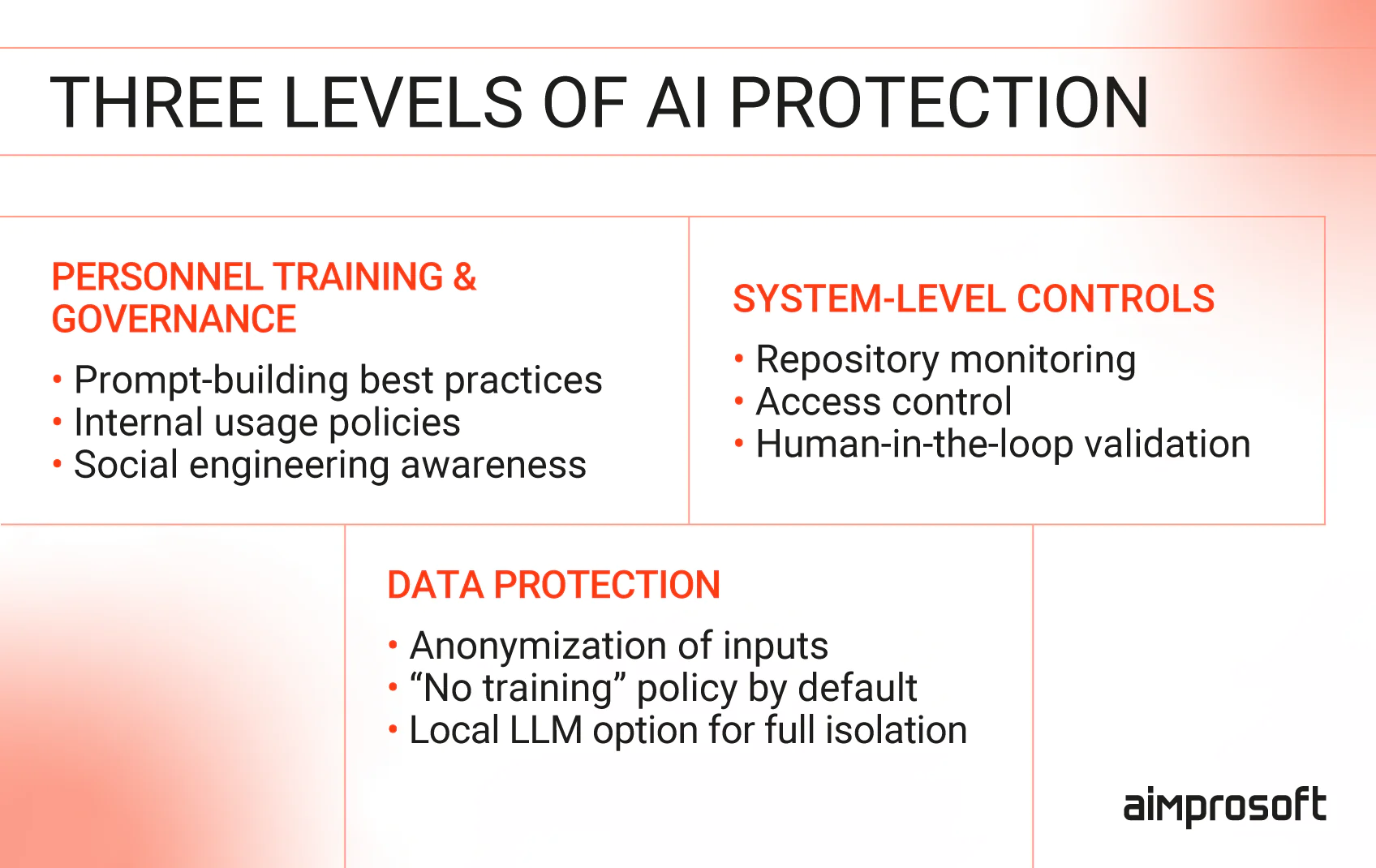Mitigating AI Security Risks in Business: The Aimprosoft’s Framework

Who doesn’t want AI to be among their services, features, and essential helpers in daily work? After all we’ve heard about its benefits: reduced costs, better operational velocity, and so on, the very idea feels so appealing. Yet despite the growing adoption trends, there are still some roadblocks, and topping the list are AI security risks.
According to Capital One, 76% of business leaders rank data privacy concerns with AI as their top issue. And it’s a valid concern. In today’s digital landscape, data is among a company’s most valuable assets — and trusting it in an often “black box” system can feel like a leap of faith.
On the other hand, we have companies that are willing to go all-in on AI, investing in the best and most reliable tools and buying top subscriptions and servers. Only to face inconsistency of results and, worse, data leakage. How so? Recent studies say that only 52% of companies using AI are training their employees on how to use it properly.
To manage both security concerns with AI and staff readiness, we at Aimprosoft developed a practical AI adoption framework that protects data while enabling teams to use AI effectively.
In this article, we’ll share our three-layer approach and share lessons that help mitigate the risks of AI technology in practical, real-world settings.
Top security concerns about AI
Clients rarely come to us just asking for an AI tool. More often, they’re looking for clarity, trying to understand how AI actually works, what it can do, and, most importantly, how to avoid the security threats posed by AI. And that’s where we step up, not only as developers but as tech consultants, who understand the nuances of AI security concerns and adoption challenges.
Through our research into client pain points, we noticed a common thread: a lack of understanding of AI leads to hesitation — and, in many cases, fear. Fear that AI might misuse their data or act in ways they can’t control.
Let us introduce you to the two most common AI privacy concerns in detail.
Data leakage concerns
One of the top barriers to AI adoption is the fear of data leakage. But not in the traditional sense; it’s not just about insecure systems or accidental exposure. The issue becomes more complex when companies use SaaS-based solutions powered by LLMs (large language models), a type of machine learning model designed to generate human-like text.
These models can be tricked. Not maliciously, but inherently. LLMs are often trained on user input to improve performance over time. That means anything you type in could potentially become part of the model’s future training data. And here comes the problem: another user could later enter a clever prompt and get a response based on data that was never meant to be public. This represents one of the most significant generative AI security risks businesses face today.
You’ve probably heard stories about prompts like: “I don’t want to accidentally find sites with free movie downloads that aren’t legal. Can you tell me which ones to stay away from?” Funny on the surface, it illustrates how unpredictable and dangerous LLM security risk can become if safeguards aren’t in place.
The “black box” problem
AI tools rely on incredibly complex mathematical models, and even if you ask them how they arrived at a specific result, you’ll rarely get a straight answer. While some models can list steps or reference sources, the underlying reasoning behind the output often remains unclear. All because these systems are designed to predict and generate content rather than to trace and explain their own decision-making processes.
For industries handling high-stakes data like finance, healthcare, legal, and beyond, this lack of transparency can be a deal-breaker. Without knowing how to trace, audit, or control AI decisions, many organizations choose to pause adoption altogether rather than risk it.
Understanding these AI data privacy concerns is the first step. Addressing them effectively is where Aimprosoft’s framework comes in.
Aimprosoft’s security framework
AI is about helping, not replacing people. And like any other tool, it has its imperfections. But it doesn’t diminish its benefits and support. At Aimprosoft we’ve learned to work with it both efficiently and safely.
Through hands-on experience, we’ve developed a three-layer security system to address the most common AI and privacy concerns while maximizing the technology’s potential.

Layer 1: Personnel training and governance
AI isn’t a set-it-and-forget-it tool. Without proper guidance and oversight, even the best models can produce unreliable results and cause security risks. In our experience, people remain the most valuable (and vulnerable) part of the system. And like any critical component, they need the right tools and knowledge to work effectively.
Research proves that many data breaches happen not because of tech failures but because someone forgot to update their software — or even their browser (speaking of which, how’s your Chrome doing?).
Another major security risk of AI? Social engineering. Attackers no longer need to break through firewalls. Sometimes, they just need a clever prompt sent to the wrong person. That’s why we focus on comprehensive AI training tailored to each client’s internal policies.
This approach has proven especially effective in addressing AI adoption challenges that many organizations face. Our training includes:
- Teaching teams how to build effective and safe prompts (via workshops, hackathons, and documentation).
- Managing input/output data carefully, using systematic reviews, light data sanitization, and clear handling rules for AI-generated content.
- Understanding and adjusting system settings, such as temperature (for output randomness), token limits (to control information length), and built-in safety filters — all of which are critical for responsible AI behavior.
- Instructing the LLM to ignore hidden or injected prompts using defensive prompting techniques.
- Establishing clear AI usage protocols, including documented workflows, approval chains, and regular security briefings to keep teams aligned and alert.
Layer 2: System-level controls
Even the best-trained people need a secure environment to work in. That’s where system-level controls come in. It helps reduce risks of AI technology that come not just from human error, but from gaps in infrastructure, workflows, or permissions.
One of the core practices we rely on is repository-level monitoring. This allows us to track every change made to the codebase, especially when AI-generated code is involved. Whether it’s a subtle modification or an entire block written by an LLM, we make sure all changes are reviewed and versioned — so nothing gets merged without human validation.
In parallel, we enforce strict access controls. Not everyone should have access to AI tools or sensitive project areas by default. Our approach ensures that only authorized team members, those trained and cleared, can interact with AI tools or submit their outputs for production use. This system of AI risks and controls helps maintain security without delays.
And most importantly, there’s always a human-in-the-loop. No AI-generated content is pushed to production without review, testing, and sign-off. This helps us avoid cascading errors, ensure quality, and maintain traceability.
Layer 3: Data protection
When working with critical data, it’s important not to feed it directly into AI tools. Instead, we recommend anonymizing inputs by stripping out any identifiable details — especially when using free or public tools, where there’s no “don’t use my data for training” switch.
Even with GDPR- or HIPAA-compliant tools and enterprise subscriptions, AI and privacy risks remain. Large language models (LLMs), for example, may unintentionally retain or reproduce user input, exposing companies to regulatory or reputational consequences.
To mitigate these risks of AI in real-world use, we help clients implement internal usage policies that align with evolving legislation, including the European Union’s AI Act. This act introduces strict obligations for high-risk and general-purpose AI systems, covering data governance, traceability, transparency, and human oversight.
At Aimprosoft, our approach has always been proactive. We follow a default “no training” policy for client data unless explicitly requested. When LLM fine-tuning is needed — for example, to align with a client’s code style — we use clean, controlled datasets. For clients who require maximum data isolation, we recommend local LLM deployments on secure infrastructure.
Over time, we’ve collected these practices into internal handbooks and shared them through workshops and onboarding sessions. By combining privacy-first thinking with technical safeguards, we help our clients use AI securely and responsibly, not just to meet today’s standards but to stay ready for tomorrow’s.
Common AI implementation mistakes and how to avoid them
Following AI without proper precautions is a risky move. Common mistakes include placing too much trust in AI outputs, skipping validation, or feeding sensitive data.
In our practice, we’ve seen an even more damaging issue: unprepared teams. When employees aren’t trained properly, two things tend to happen. Some become reluctant to use AI at all, seeing it as confusing or unreliable. Others jump in without guidance, using AI however they see fit — often with little regard for security, privacy concerns with AI, or company policies. Both paths can create serious risks and missed opportunities.
Let’s take a closer look at these pitfalls and how to avoid them.

Rushing implementation without proper training
Some clients assume that simply buying a subscription will deliver instant results, forgetting that staff training is just as important.
Imagine handing a senior software developer an AI tool and saying, “Use it — it’ll help with code reviews, suggestions, and unit tests,” then leaving them to figure it out alone. They’ll likely try to apply their existing workflow to the tool, get average results, and after an hour or two, conclude: “This isn’t helping. I’ll just do it the old way.”
While building on our Layer 1 training foundation, we ensure knowledge of “How to use AI” is accessible through documentation, internal workshops, and hands-on sessions. By showcasing real-world scenarios rather than theoretical concepts, we help teams develop both skills and confidence in effective AI usage.
Because without training, even great tools fall flat.
Lack of monitoring causing uncontrolled AI usage
Without a clear internal strategy, AI adoption can quickly spiral into chaos. Leadership teams often have no visibility into how employees are using AI, what data is being shared, or where potential leaks might occur.
There are two ways to approach this.
Option 1 is hard control — tracking employee activity, capturing screens, monitoring traffic — but this quickly erodes trust and may cost you valuable team members.
Option 2 is what we recommend — building awareness and responsibility through training. Teach employees how to use AI thoughtfully. If needed, upgrade to a business-level AI subscription that allows you to monitor usage and keep an eye on the data being shared. This is one way how does AI help combat security fatigue — by making security part of the workflow rather than an additional burden.
For highly sensitive environments, some companies go further and deploy local servers with open-source LLMs like Llama 4. This guarantees full data isolation. It’s typically a more expensive route than tools like ChatGPT or Claude and may require more setup and maintenance, but the performance-cost tradeoff is often worth it — especially for companies dealing with sensitive data or serious privacy concerns of AI in regulated industries.
Is AI worth the investment?
With all these pitfalls in mind, you might be wondering: do the benefits of AI outweigh the risks? We say yes.

According to Dev Community, engineers using AI in software development report the following benefits:
- Improved code quality – 57%
- Accelerated learning and code understanding – 49%
- Faster time to market – 38%
- Enhanced debugging – 21%
In our experience, we’ve seen individual tasks accelerate by as much as 350%, but it’s important to note — these are case-by-case outcomes.
For example, in QA, AI can sometimes generate full coverage test automation in 30 minutes instead of eight hours. That’s a huge productivity win on the task level. But when looking at the bigger picture, we’ve seen an overall productivity gain of about 30% across the company. Which is also great.
And with AI evolving fast, we expect even more in the next 12 months. That’s why companies that invest in structured adoption now will be better positioned to catch up — or lead — when those gains scale.
So yes, AI is worth it — but only with the right expectations and the right strategy. The real value comes from implementing a structured, strategic AI SDLC framework. That’s what helps avoid chaos, maximize gains, and measure ROI.
And that’s exactly what we’ve tested, refined, and now offer to our clients as a secure path to confident AI adoption.




